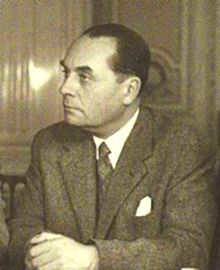Ranuccio Bianchi Bandinelli
| Ranuccio Bianchi Bandinelli | |
|---|---|

Ranuccio Bianchi Bandinelli in 1949
|
|
| Born | 19 February 1900 Siena, Italy |
| Died | 17 January 1975 Rome, Italy |
| Nationality | Italian |
| Occupation | Roman archaeologist |
| Known for | Roman archaeology and art history |
Ranuccio Bianchi Bandinelli (19 February 1900 – 17 January 1975) was an Italian archaeologist and art historian.
Bianchi Bandinelli was born in Siena to Mario Bianchi Bandinelli (1859–1930) and Margherita Ottilie "Lily" von Korn (Bianchi Bandinelli, 1878–1905), who were descended from ancient aristocracy in Siena. His early research focused on the Etruscan centers close to his family lands, Clusium (1925) and Suana (1929). Disgusted with Italian fascism, despite being the man who showed Hitler around Rome under Mussolini, he converted to communism after World War II and became a Marxist. As an anti-fascist, he was appointed to a number of important art-historical positions immediately after the war. For example, he was director of the new government's fine arts and antiquities ministry (Antichità e Belle Arti, 1945–48). His memoir of fascism in Italy was published in 1995 (Hitler e Mussolini, 1938: il viaggio del Führer in Italia).
From his chairs at the universities of Florence and Rome, Bianchi Bandinelli directed a new breed of Italian archaeologists sensitive to classical history based upon dialectical materialism. He also taught at the University of Groningen in the Netherlands. In the 1950s and 1960s he undertook the writing of comprehensive texts on classical art intended to reach a wide and literate audience. He founded the Enciclopedia dell'arte antica in 1958, and in the same year was elected as a foreign member of the Soviet Academy of Sciences. In the mid 1960s, Bianchi Bandinelli was commissioned to write the two volumes on Roman art for the French Arts of Mankind series. These works brought his writing to a larger audience and helped usher in social criteria for art into a larger and English-speaking audience. In 1967 he founded the Dialoghi di archeologia with his students, one of the most innovative, if controversial, periodicals on classical archaeology.
...
Wikipedia
